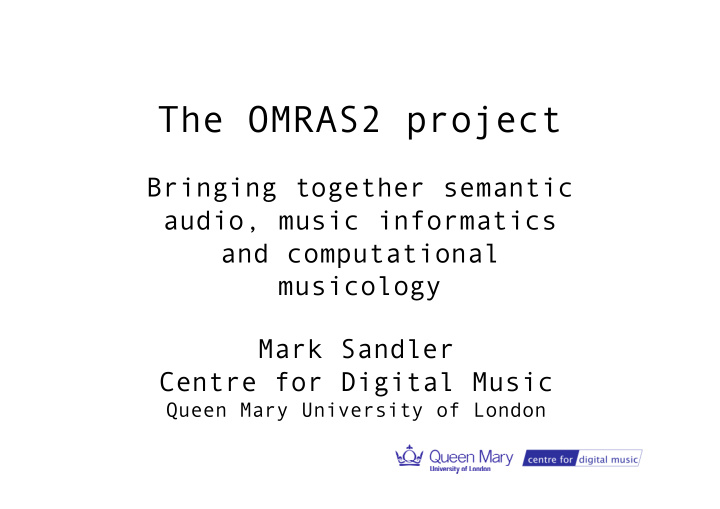



The OMRAS2 project Bringing together semantic audio, music informatics and computational musicology Mark Sandler Centre for Digital Music Queen Mary University of London
Music Information Retrieval is maturing • Components for – Beat tracking – Temporal segmentation – Instrument separation and identification – Key and chord analysis – … • Systems for – Recommending artists – Following lyrics – Generating playlist – Navigating collections – Personalized radio
So what’s missing… • integrated systems for non- programmers (musicologists) • intuitive interaction for music professionals (producer or musicologist) • infrastructure for music informaticists to test new algorithms in a meaningful workflow • Few facilities for distributed researchers to work together
Questions people would like answered: Artifical Music Intelligence • “Find all guitar recordings that exhibit performance influences of either Robert Johnson or Jimi Hendrix”. • “Find a score that is strongly related to an audio query” • “Find the recording that exactly matches the audio query (Shazam etc)” • “Find similarities within pieces and across collections” • “Help me understand this singer’s vibrato” • “Represent structure (movement, chorus, etc.) and find the chorus start” • “Tell me if this will be a hit” • “Make me a sad (happy) playlist”
In a nutshell.. • Music Informatics is all about semantics, extracting and representing information hidden inside the music (audio and score) and then using it • There is a natural and obvious affinity to the Semantic Web
OMRAS2: Musical Informatics and Computational Musicology • Multi-platform UIs • Web services API • Distributed compute & data resources • Users unaware of resource location • QMUL, Goldsmiths, Royal Holloway, King’s, Lancaster, Surrey, .. • £2.5M UK investment • 3.5 yrs • 6 FTE Post Docs, 5 PhDs
For Whom? • Music Information Scientists and Technologists • Music Information Retrieval(ists) • Musicologists • Other Music professionals • Music Fans
Purpose • Construct open framework for Music Informatics research using available Intellectual Property • Test it with novel components • Test it on real problems • Disseminate, esp. with workshops • Software releases – v1 2Q 08 – v2 4Q 09
OMRAS2 Technologies • Audio - Segmentation, key, chords, BPM etc • Symbolic - theme finding • Hybrid - esp. for automatic annotation • SOAP and Web Services • Semantic Web, esp. Music Ontology and RDF • Sonic Visualiser and other user interaction modalities
Fundamental Research • Knowledge representation for music • Music ontologies • Large-collection user interfaces • Harmonic analysis • Semi-automatic annotation • Subjective evaluation of MIR systems • Distributed temporal data-bases • Semantic Grid indexing and searching of music
Summary • Today’s research provides musical semantic features – Structure, rhythm, harmony, melody, sources • Semantic Web provides means to process, reason, search using appropriately represented features • OMRAS2 project builds on this – Providing intuitive tools to supercharge research • And provides a test-bed for Music 2.0
Recommend
More recommend